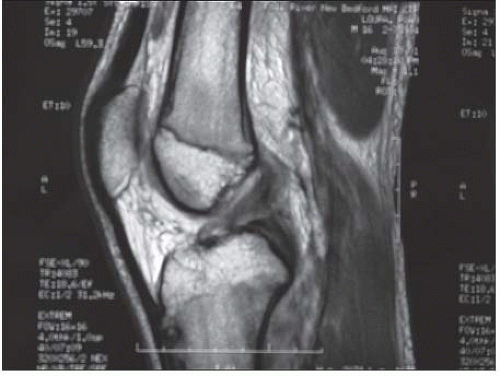History and Physical Examination
Important history questions are as follows:
1. How did the injury occur?
2. Were you able to continue to compete?
3. Was there significant swelling directly after the injury?
4. Have there been previous injuries to the knee?
Our understanding of ACL tears in the setting of younger athletes has changed considerably. The tibial spine fracture was once thought to be the pediatric equivalent of an ACL tear. Midsubstance ACL ruptures are now diagnosed more frequently in pediatric athletes
participating in cutting and contact sports. The typical presentation is a young athlete who has a decelerating, twisting injury. Approximately two-thirds of ACL injuries occur by noncontact mechanisms (
10). The patient will often report a “pop” and the inability to return to the field. A large amount of swelling due to hemarthrosis is expected. The presentation is less dramatic in athletes who have had a prior partial tear of the ACL.
The findings on physical examination are dependent on the timing in relation to the injury. Directly after the injury, the stability of the knee can be tested on the sideline. The Lachman and pivot shift tests are positive before swelling and guarding occurs. When the patient presents for evaluation in the emergency department or clinic, the knee is typically swollen, compromising the ability to perform an accurate physical examination. Rates of ACL injury are reported between 10% and 65% in pediatric patients presenting with traumatic hemarthrosis of the knee; therefore, young athletes presenting with a hemarthrosis of the knee should raise suspicion for an ACL tear (
11,
12). The differential diagnosis of hemarthrosis of the knee includes patellar dislocation, meniscal tear, osteochondral fracture, tibial spine fracture, and epiphyseal fracture of the femur or tibia.
A thorough examination of the knee must be performed to rule out concomitant injuries. Associated injuries include meniscal tears, posterior cruciate and/or collateral ligament tears, osteochondral fractures, and physeal fractures of the distal femur or proximal tibia. Given the higher prevalence of generalized ligamentous laxity in skeletally immature patients, a direct comparison to the contralateral knee should also be made. The Lachman and pivot shift maneuvers are used to test for ACL insufficiency.











